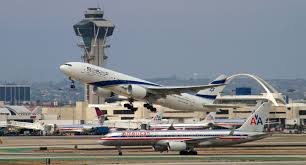The idea has been debated for decades, but caught a swift tailwind as President Trump promised big benefits for American taxpayers and millions of airline passengers.
“Today, we are proposing to take American air travel into the future, finally,” Trump said in an East Room signing ceremony. “We’re proposing reduced wait times, increased route efficiency, and far fewer delays. Our plan will get you where you need to go more quickly, more reliably, more affordably and, yes, for the first time in a long time, on time.”
In addition to bold promises to make the planes run on time, Trump underscored how his plan will facilitate long-delayed technology upgrades in air traffic control (ATC), allowing the industry to obtain “the best, newest, and safest technology available.”
The proposal fits Trump’s campaign promise to reduce the size and costs of government. The White House expects that by shedding responsibility for operating air traffic control, the federal government could save as much as $10 billion per year starting in 2021.
The plan was unveiled just days before Transportation Secretary Elaine Chao goes to Capitol Hill to present the president’s 2018 budget request for the Federal Aviation Administration (FAA), which will include the plan take air traffic control out the hands of the aviation regulator.
Critics of the plan quickly responded, denouncing it as a “privatization” scheme, that would make the skies less safe, derail existing aviation modernization efforts, and wind up costing Americans more in user-fees than they are now paying in taxes.
House Minority Leader Nancy Pelosi announced her opposition to the proposal, arguing it would “hand control of one of our nation’s most important public assets to special interests and the big airlines.”
The Professional Aviation Safety Specialists (PASS), a union representing 11,000 government employees in the FAA and Department of Defense, argued that the White House’s plan would “establish a monopoly” in favor of the new non-governmental organization while introducing “uncertainty and risk.”
But the support runs deep for the changes outlined by President Trump. Lawmakers, aviation trade organizations, the nation’s largest airline carriers including Southwest and American Airlines, and even government worker’s unions have all expressed their support for important aspects of the proposal, most emphatically modernization.
President of Southwest Airlines Pilots’ Association, Jon Weaks, applauded Trump’s effort, saying, “By expediting modernization, Mr. President, we will indeed make American aviation great again.”
Whether or not Trump’s plan goes into effect is now in the hands of Congress.
Rep. Bill Shuster (R-Penn.) is the chairman of the House Transportation and Infrastructure Committee and the author of the legislation the White House used as a model for its aviation reform.
Shuster pushed for the Aviation Innovation, Reform, and Reauthorization (AIRR) Act to be included in a must-pass FAA authorization bill in 2016, but it was shot down.
In an interview with Sinclair Broadcast Group, Shuster stressed that having President Trump’s support will help push the reform across the finish line.
“When you have presidential leadership it really makes all the difference in the world when you’re trying to do something as transformational as we’re trying to do with the FAA and air traffic control,” Shuster noted.
What the White House and Republicans in Congress are pushing will mark a fundamental change in federal aviation. Right now the FAA is one of the only government agencies that acts as both a regulator and an operator of air traffic control. The United States is also one of the few industrialized nations that has a government agency in charge of air traffic control.
The reform bill would separate out the two functions. The FAA would still be responsible for aviation safety and regulations, but day to day operations, guiding and tracking planes, managing and investing in equipment would be overseen by a private non-profit corporation. The corporation would be run by a board of directors representing the airlines, unions, the government, air traffic controllers and other stakeholders.
The 30,000-person workforce of air traffic controllers would also be taken off the government payroll with the jobs shifted to private sector. All operating costs for the world’s most complex ATC systems would be passed on to the private, non-profit corporation.
Advocates of the reform hope that under the private management, air traffic control will be driven to be more efficient, less costly and more innovative.
Sen. Bill Nelson of Florida, the lead Democrat on the Transportation Committee worries that changes in pursuit of lower costs could jeopardize the safety of all air passengers.
“The safety of the flying public should not be for sale,” Nelson said on Monday. “Handing air traffic control over to a private entity partly governed by the airlines is both a risk and liability we can’t afford to take.”
The United States now has the safest air traffic control system in the world. It is also the most highly trafficked national airspace with more than 50,000 flights every day. But experts argue that shifting to GPS technology will make the skies safer, allowing air traffic controllers better awareness to more accurately track planes.
In his speech on Monday, President Trump pointed to the billions of dollars spent by U.S. taxpayers each year to maintain an “ancient, broken, antiquated, horrible system.” The government has fallen into a pattern of paying a premium to make incremental improvements to legacy technology, while putting off popular upgrades.
In part this is because Congress is responsible for appropriating the funds for the FAA, which includes about $10 billion annually for air traffic control. Dysfunction in Washington and budget uncertainty has delayed long sought after modernizations.
Those improvements in technology will make the biggest difference for passengers, Shuster said.
“A more efficient system with better technology will drive the costs down in general,” he explained. “[Passengers] will see, over time, less flying time, less delays. We’ll reduce our carbon footprint by using less fuel, which drives down the cost.”
But investing in new GPS systems for the nation will not be cheap. Trump and congressional Republicans insist that the the corporation will be able to pay for modernization through user fees and “access to capital markets and investors.” Americans would no longer be responsible for paying the ticket tax. Instead, user fees would go towards the cost of modernization and daily operations.
Senate Minority Leader Chuck Schumer compared the plan to other infrastructure privatization plans, saying, “It means Trump tolls from one end of America to the other.”
Even some Republicans are wary of the way the president hopes to fund aviation improvements. Transportation Committee Chairman John Thune (R-S.D.) said on Tuesday that the user fees could actually price some people out of the market, because they “tend generally disproportionately impact people in rural areas.”
It is also possible that the average American could wind up paying more in user fees under the new system than what they were paying before in ticket taxes to fund the FAA.
Rep. Blake Farenthold (R-Texas) advised that Americans “could potentially see a reduction in the ticket tax,” quickly adding “[we’re] not promising that, but it is a possibility.”
Ultimately, Farenthold believes the changes are good deal for passengers. “They’re going to be safer when they’re flying, it ought to bring efficiency up and costs down for the airlines,” he said, adding that “hopefully the airlines will pass some of those savings on to the customers.”
Based on the details outlined by the White House and Shuster’s legislation, which is still in draft form, it is not yet clear whether American air travelers will see friendlier skies. But there is the strong hope that the United States will be able to reform its own ATC with as much success as other nations.
The White House and members of Congress have repeatedly pointed to Canada’s private air traffic control, Nav Canada as the model for U.S. privatization. Canada turned over air traffic control to Nav Canada in 1996, a private non-profit organization, and they now have the most cutting edge technology, lower costs paid in user fees and faster service than the United States.
While the U.S. airspace supports about ten times the volume of Canadian airspace and is far more complex, Shuster argued that is precisely why air traffic control should be taken out of government control.
“People say we’re too big … That’s not a reason not to do it, that’s a reason to do it. Let American innovation and ingenuity do it.”






